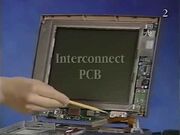- "PowerBook 500" redirects here; there was never a "PowerBook 500" model.

Service Training PowerBook 500 Series - December 1994 - Apple VHS Archive
The PowerBook 500 series was introduced in May 1994. Codenamed "blackbird", the 500 series was the second major update to the PowerBook line, after the PowerBook Duo series and since the first PowerBooks were released in 1991.
Models[]
The 500 series encompass the following PowerBooks:
- PowerBook 520
- PowerBook 520c
- PowerBook 540
- PowerBook 540c
- PowerBook 550c (released later)
The PowerBook 280 and PowerBook 280c were introduced at the same time, but they belong to the PowerBook Duo series.
Features[]
The PowerBook 500 series also introduced dual swappable "bays" that could be used to hold either one battery and a PCMCIA adapter or dual batteries to extend runtime.
Trackpad[]
The most significant change to the new PowerBooks was the replacement of the trackball with the trackpad. The trackpad was praised as a revolutionary input device and adopted by the majority of other modern notebooks. Switching over to the trackpad was intuitive and preferred by users.
The trackball was never seen again in the PowerBook line. The trackpad continued its evolution throughout the whole PowerBook line and even made itself into the iBook line of portable Macs in 1999.
PCMCIA[]
Just after the launch of the new PowerBooks, Apple announced the PowerBook Expansion Module for USD 199, which enabled the new PowerBooks to accept PCMCIA cards (or PC cards for short).
The PowerBook 500 series can accept one Type III PCMCIA card or two Type II PCMCIA cards. Initially, however, the Macintosh system software restricted use of Type II cards to just one card at a time.
Battery[]
The PowerBook 500 series also introduced dual swappable "bays" that could be used to hold two batteries to extend runtime, or one battery with a PCMCIA adapter in the other bay to use PC cards.
The new battery that accompanies the 500 series PowerBooks -- the PowerBook Intelligent Battery -- is a multicelled NiMH power pack with a built-in chip which tracks power usage and tells the PowerBook how to manage and preserve power. The new battery lasts 2 - 4 hours per charge, depending on how the user actually uses the laptop.
References[]
- MacUser magazine, July 1994: "All New PowerBooks", pages 78 - 83
External links[]
- Blackbird: The PowerBook 500 Series at Low End Mac (1994-05-16)
- PowerBook 500 series at Wikipedia
